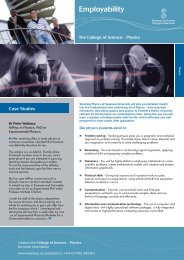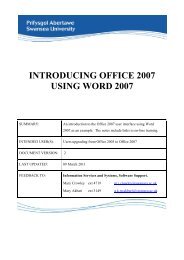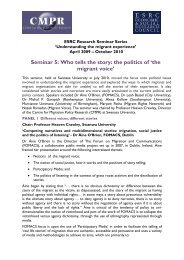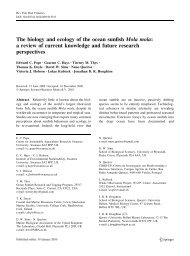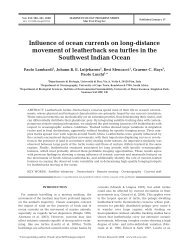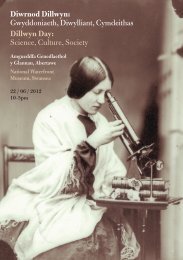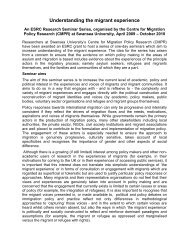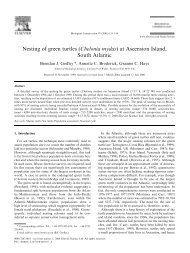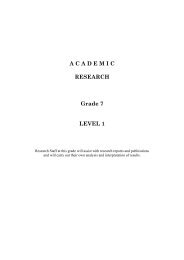The energy density of jellyfish - Swansea University
The energy density of jellyfish - Swansea University
The energy density of jellyfish - Swansea University
You also want an ePaper? Increase the reach of your titles
YUMPU automatically turns print PDFs into web optimized ePapers that Google loves.
248 T.K. Doyle et al. / Journal <strong>of</strong> Experimental Marine Biology and Ecology 343 (2007) 239–252<br />
1.5) (Table 5). Both the lipid and carbohydrate fractions<br />
were normally less than 1.2% <strong>of</strong> DM for all tissue types;<br />
however small sample size limited further analysis<br />
(Table 5). A similar picture emerged for the organic<br />
content <strong>of</strong> R. octopus, which comprised relatively large<br />
amounts <strong>of</strong> protein, and relatively minor amounts <strong>of</strong> lipids<br />
and carbohydrates (Table 5). However, these differences<br />
between individual tissue types were not as large as the<br />
protein differences observed between both gonads and<br />
oral arms and the bell components <strong>of</strong> C. capillata.<br />
3.1.3.3. Energy <strong>density</strong> from proximate composition.<br />
Mean gross <strong>energy</strong> <strong>density</strong> estimates obtained using<br />
proximate composition ranged from 2.83 to 4.30 kJ g<br />
DM − 1 , for whole <strong>jellyfish</strong> (Table 3). C. capillata had<br />
a higher mean GE content (4.30 kJ g DM − 1 ) than<br />
R. octopus. For C. capillata, there were significant<br />
differences between the GE <strong>of</strong> the different tissues i.e.<br />
bell tissue had significantly lower <strong>energy</strong> <strong>density</strong> (mean:<br />
2.16 kJ g DM − 1 ) than both the gonad (mean: 7.19 kJ g<br />
DM − 1 ) and oral arm (mean: 7.81 kJ g DM − 1 ) tissues<br />
(ANOVA: F 2, 30 =224.78, p b0.001). Sample size<br />
limited further analysis <strong>of</strong> R. octopus (Table 3), although<br />
similar to C. capillata, the bell tissue had the lowest GE<br />
(mean: 1.87 kJ g DM − 1 )(Table 3).<br />
3.1.3.4. Total biochemical composition and unmeasured<br />
fraction. <strong>The</strong> chemical analysis <strong>of</strong> whole<br />
C. capillata highlights the fact that that the dried samples<br />
mostly comprised inorganic matter, i.e. the mean ash<br />
content was 76.8% DM (Table 4). Within the organic<br />
proportion <strong>of</strong> the <strong>jellyfish</strong> samples, protein was by far the<br />
most abundant fraction (10.1–22.6% DM), with the sum<br />
<strong>of</strong> lipids and carbohydrates contributing to less than 1.4%<br />
<strong>of</strong> DM (see C. capillata id number 14, Table 5). This is<br />
equivalent to approximately 7–16 times more protein in<br />
whole specimens <strong>of</strong> C. capillata than the sum <strong>of</strong> lipids<br />
and carbohydrates. Note that the sum <strong>of</strong> all fractions did<br />
not add up to 100% DM (e.g. see C. capillata #14<br />
Tables 4 and 5: 66.8 ash+(18.4+0.45+0.90) total<br />
organic matter=86.55% DM). This implies that there<br />
was a large fraction <strong>of</strong> matter in the samples that was not<br />
measurable by the methods employed in the study. A<br />
similar unmeasured fraction was found for R. octopus<br />
(i.e. see R. octopus #2 Tables 4 and 5: 71.8 ash+(14.5+<br />
0.32+0.83) total organics=87.45% DM).<br />
3.2. Revised results after correcting for bound water <strong>of</strong><br />
hydration<br />
Both bomb-calorimetry and proximate-composition<br />
raw GE values were revised assuming 11.7% DM ‘water<br />
<strong>of</strong> hydration’ calculated by Madin et al. (1981), Larson<br />
(1986), Clarke et al. (1992), and Lucas (1994).<br />
Importantly, after revision, the sum <strong>of</strong> all fractions<br />
measured by proximate-composition was ∼100% DM<br />
(e.g. see C. capillata id number 14 Tables 4 and 5).<br />
Revised mean <strong>energy</strong> densities from bomb-calorimetry<br />
were 4.22, 2.80 and 2.42 kJ g DM − 1 for C. capillata,<br />
R.octopus and C. hysoscella respectively. Individual<br />
tissues <strong>of</strong> C. capillata differed significantly (ANOVA:<br />
F 2, 22 =46.09, pb0.001) with bell tissue (1.64 kJ g<br />
DM − 1 ) having much lower <strong>energy</strong> content than both oral<br />
arm (7.98 kJ g DM − 1 ) and gonad (7.55 kJ g DM − 1 )<br />
tissues (Table 3).<br />
Revised mean <strong>energy</strong> densities from proximate-composition<br />
were 3.21 and 4.73 kJ g DM −1 for R. octopus and<br />
C. capillata respectively. Individual tissues <strong>of</strong> C. capillata<br />
differed significantly (ANOVA: F 2 , 30 =79.22, pb0.001)<br />
with bell tissue (2.44 kJ g DM −1 ) having much lower<br />
<strong>energy</strong> content than both oral arm (8.39 kJ g DM −1 )and<br />
gonad (8.14 kJ g DM −1 ) tissues (Table 3).<br />
<strong>The</strong>re was no significant difference between the<br />
revised GE values derived from both methods for<br />
C. capillata whole <strong>jellyfish</strong>, and its gonad and oral arm<br />
tissues (ANOVA: pb0.05). However, GE values obtained<br />
from bomb-calorimetry for C. capillata bell tissue were<br />
significantly different from the corresponding proximatecomposition<br />
values (ANOVA: F 1 , 17 =12.10, pb0.01).<br />
Small sample sizes for R. octopus limited similar analysis.<br />
<strong>The</strong>re was a significant relationship between revised<br />
ash content and <strong>energy</strong> <strong>density</strong> <strong>of</strong> individual tissues<br />
derived from proximate composition (pb0.001). Similarly,<br />
there was a significant relationship between<br />
revised ash content and <strong>energy</strong> <strong>density</strong> <strong>of</strong> individual<br />
Fig. 2. Relationship between revised ash content and <strong>energy</strong> <strong>density</strong><br />
(kJ g wet mass − 1 ) for individual tissues <strong>of</strong> <strong>jellyfish</strong>. Circles=Cyanea<br />
capillata, triangles=Rhizostoma octopus, open symbols=proximatecomposition,<br />
filled symbols=bomb-calorimetry, crosshairs =whole<br />
<strong>jellyfish</strong> (spp. or method not specified). Energy <strong>density</strong> (kJ g wet<br />
mass − 1 ) =1.21–0.0132 (% revised ash), r 2 =0.847, pb0.001.



